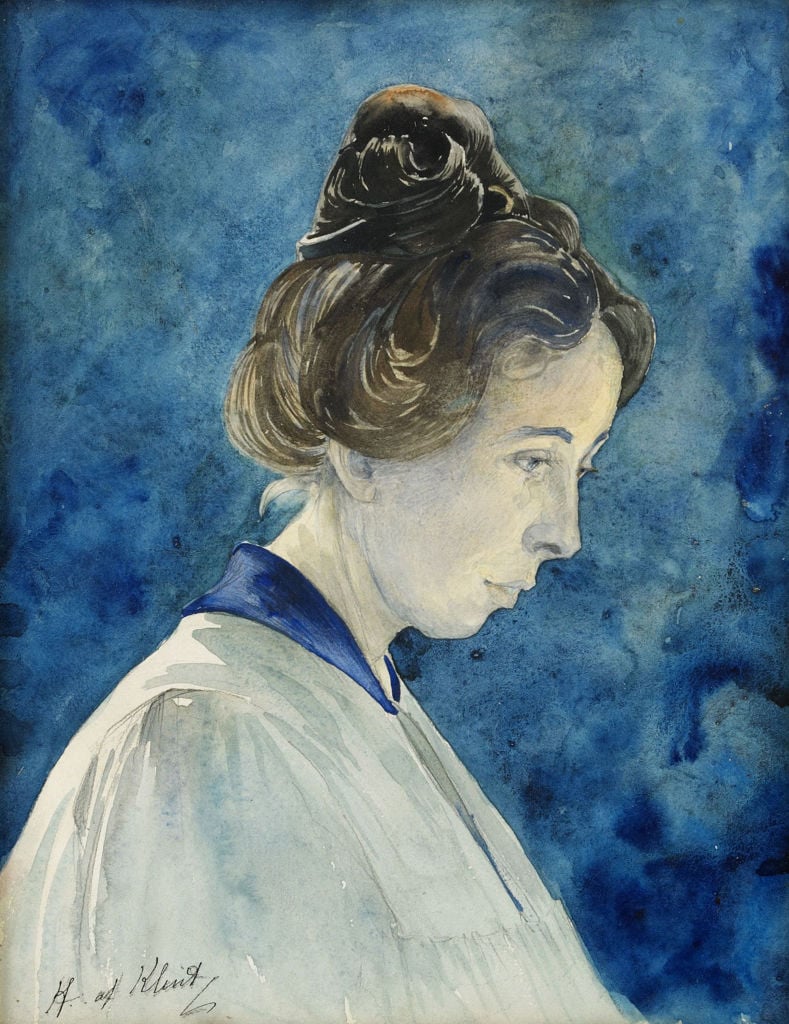The Swedish painter Hilma af Klint died nearly eight decades ago in relative obscurity, but you might not realize this if you look her up today. Her paintings—large-scale, vivid masterpieces infused with mysticism and symbolism—seem uncannily contemporary.
In spite of her struggle for recognition during her own lifetime in the early 20th century, af Klint is now a bona fide star in the art world. In the past several years alone, there has been an explosion of interest in her work, catalyzed in no small part by a blockbuster 2018 Guggenheim show in New York. A large exhibition called “Swedish Ecstasy” at BOZAR Centre for Fine Arts, now on view in Brussels, highlights her work and, right on its heels is an upcoming show at the Tate Modern, which will pair Hilma af Klint and Piet Mondrian, on view from April 18. Next year, for the first time ever, there will be a show dedicated to Kandinsky and af Klint.
Af Klint’s body of work, which bravely departed from the figurative art that was popular at the turn of the 20th century, predated the first Western abstract compositions by Wassily Kandinsky and Piet Mondrian. It was a staggering revelation, to say the least. As the art world rushes to fit it into an art historical canon that has woefully excluded women, it is important to move beyond the catchphrases that have emerged around af Klint: Up until recently, many of the intricacies of her life, work, ambitions, and friendships, were not well-understood.
That is part of the reason why journalist and art historian Julia Voss decided to write the first-ever biography on the artist, which came out in English at the end of last year. Voss spent the better part of a decade learning Swedish and meticulously retracing af Klint’s life and her movements in Europe, combing through more than 20,000 notebooks that belonged to the artist. The new biography includes several revelations about the Swedish painter’s inner life and desires.
Voss spoke with Artnet News Europe editor Kate Brown, diving into some of the more fascinating and under-considered aspects of the enigmatic and groundbreaking artist.
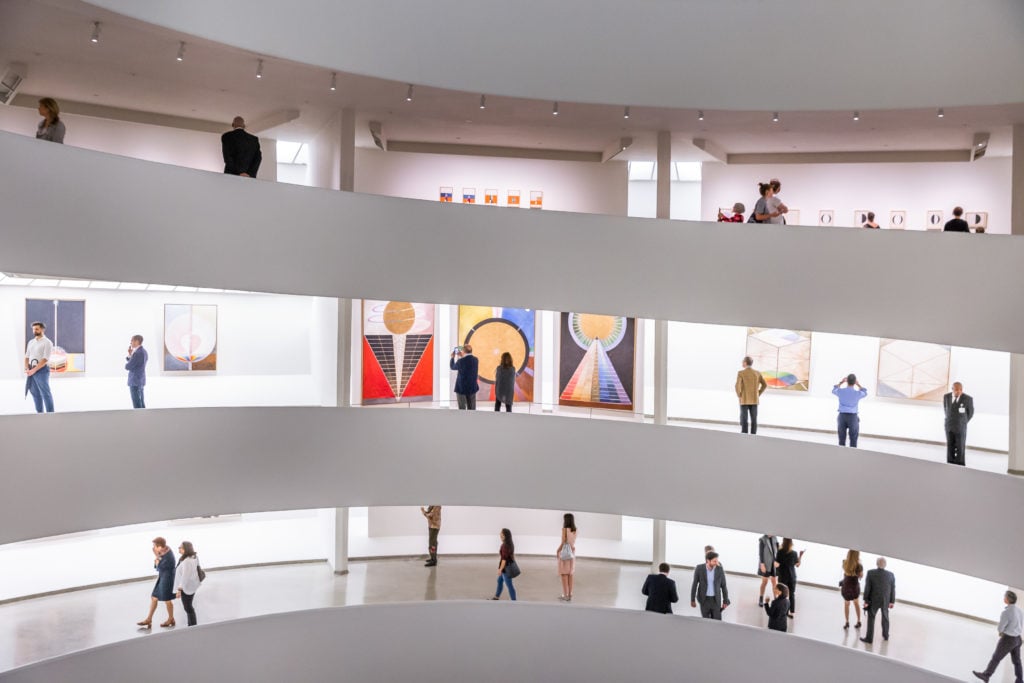
Opening for “Hilma af Klint: Paintings for the Future.” Photo by Paul Rudd, ©Solomon R. Guggenheim Foundation.
Note: This interview has been edited for clarity. To hear the full audio version, tune into the episode on the Art Angle podcast.
Throughout your book you set the scene in Europe and in Sweden in particular, where Hilma af Klint spent most of her life between the late 19th century and early 20th century. You describe an art world and a society that is bursting with change and revolution, but also extreme sexism in the public sphere. This is af Klint’s Europe. I was hoping you could expand on this for me and explain just how difficult it was for her to garner attention in the art world.
Sexism is a good point. I expected it when I was researching for the book, but I didn’t expect it to be so outspoken. In the 19th century, nobody even tried to hide it. Even at the academy where af Klint is studying, there are a lot of male artists who completely despise their fellow female students, and they’re very open about this. The sexism stems from the art academy but also medicine and the sciences. The question of whether women should have an education and go to work is a big concern.
It’s a time of change. There are a lot of political revolutions, reformations, and scientific revolutions. I think one movement that’s very important for af Klint happens in the world of science. That is the discovery of all kinds of invisible forces. By this I mean X-rays and radioactivity. Then, a strange thing happens. One of the persons who is receiving the Nobel Prize is a woman. That’s a game changer.
That’s quite interesting to hear because also that is another important revision need to the big narrative that everyone knows about af Klint, which is that she was solely a spiritual mystic—for her mysticism was very much grounded in science and not just spirituality. It causes a certain rereading of her paintings.
I think without this scientific revolution, her artwork wouldn’t look the same. It’s really something that she follows closely. She’s not the only artist who follows these developments closely—so does Wassily Kandinsky. For both, science in those days opened up completely new ways to look at the world. She also worked at a veterinary institute in Stockholm. I think this idea that being a mystic only comes from a kind of religious, spiritual world is something that needs to be reconsidered in the light of this.
Af Klint is very influenced by many political movements, scientific movements, and spiritual movements; they all come together in her work and in her life and shape the way she paints and the way she thinks.
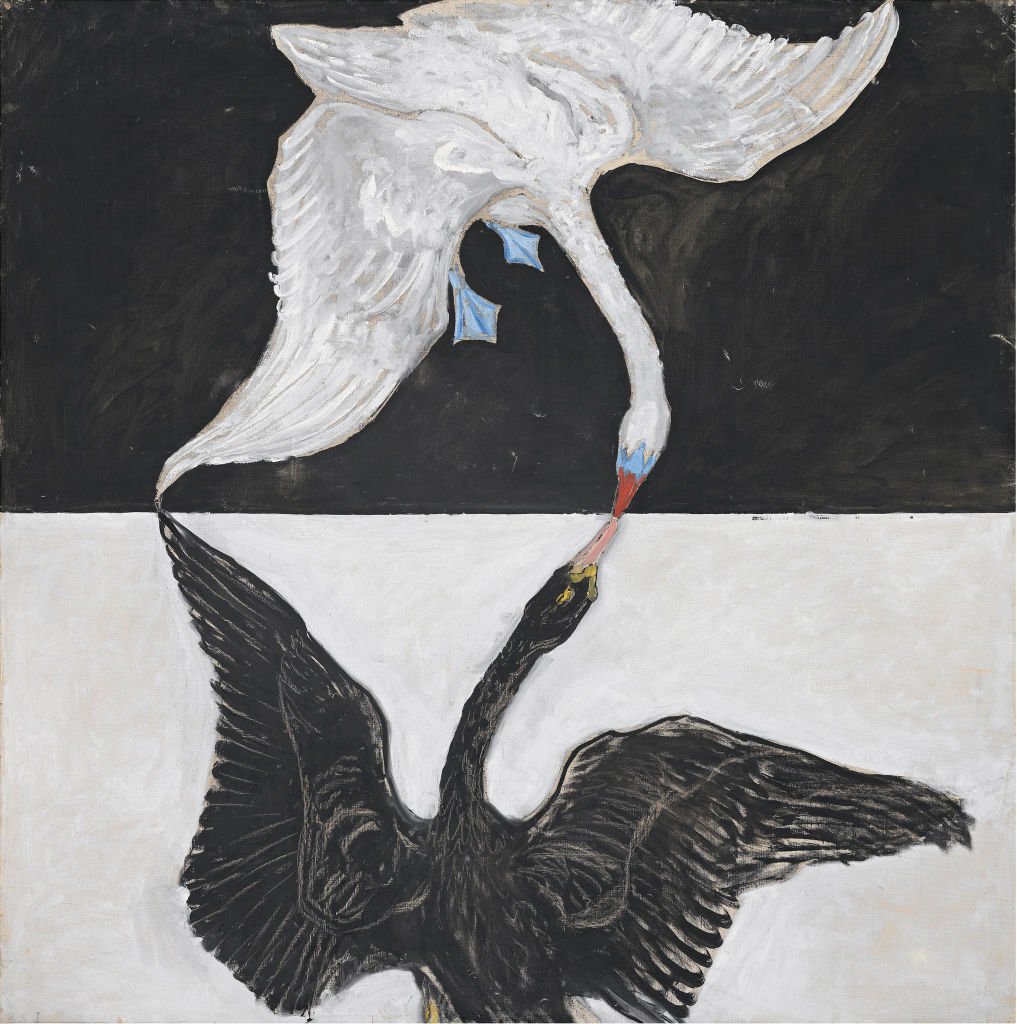
Group IX/SUW, No. 1, The Swan, No. 1, (1914-1915). Found in the Collection of Courtesy of Stiftelsen Hilma af Klints Verk. Artist Hilma af Klint (1862-1944). Photo: Fine Art Images/Heritage Images/Getty Images
In your book, you also described the invention of the telephone and moving images as being influential. It makes so much sense, given these inventions, that there would be speculation that in the future one might be able to speak with the spirit world, which is what af Klint and her peers do. Throughout the book, you share many quotations from these spirit visitations. Who were these people from the spirit world who were visiting her, and how did they inform her paintings? How did you interpret this as a biographer?
She works in a collective of women, always surrounded by her friends, sometimes also lovers. And then she is visited by spiritual forces, spiritual voices that inform her. In the beginning I was a bit put off by that, I have to say. Given my journalism background, I didn’t know how to deal with it. I wanted to have a self-confident, avant garde woman who defines what she’s doing rather than being told what she’s doing.
And then when I read her notebooks, I realized that it was different than I thought. It’s a dialogue. She’s in dialogue with these forces and they’re more like invisible friends. They support her, they make offers. They ask her whether she wants to do something, and then she says yes; sometimes, she doesn’t. I think that’s very different from being told what to do or being commissioned. Until her very last days, these voices are with her.
The interpretation is a difficult question. In the beginning, I thought maybe it gives her an opportunity to do something she wasn’t allowed to do by her society, where the art world would say this kind of painting is nothing for a woman, where science would say women are not made to be geniuses, where religion would say, you’re not supposed to talk to any other spiritual forces than the Christian God. So my first interpretation was that it’s a cover up. But the more I read it, the more I was ready to accept that this is completely her reality and that I should not judge it.
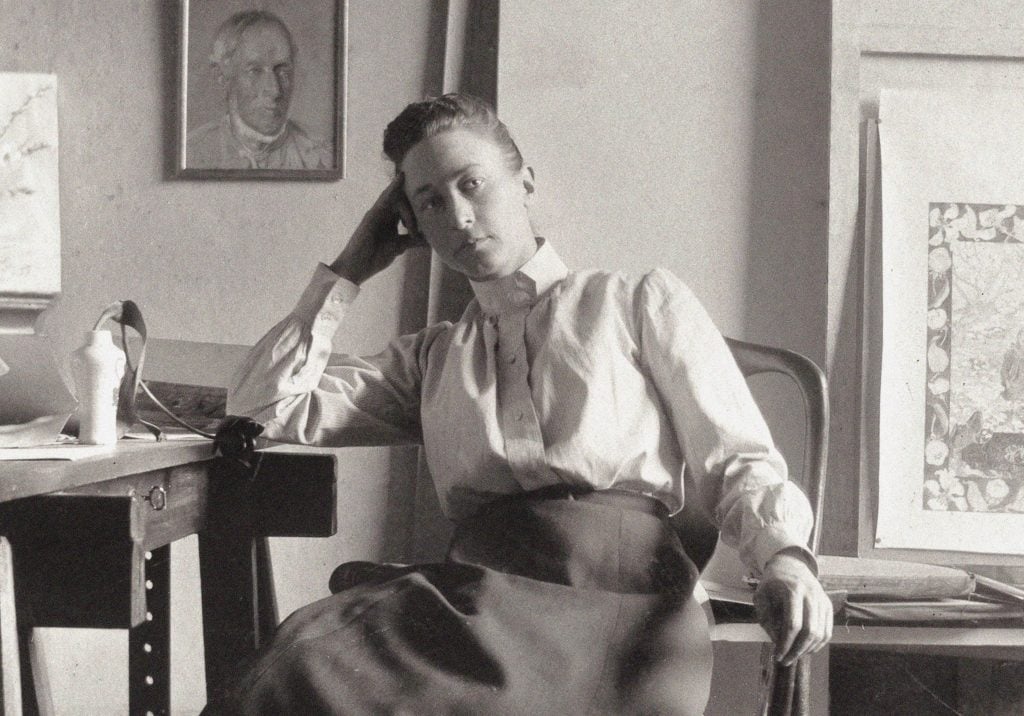
Hilma af Klint in her studio at Hamngatan, Stockholm, circa 1895. Found in the collection of Courtesy of Stiftelsen Hilma af Klints Verk. Artist Anonymous. Photo: Fine Art Images/Heritage Images via Getty Images.
In line with what you were saying a little earlier about looking to the future, looking into the spirit world may have been a way to deal with or circumvent the oppression of the present society. She was having a lot of discussion about new eras of art, but also new definitions of what it means to be male and female. I found this so contemporary. She spoke about androgyny and new gender roles and role reversals. As I understand—and I think you navigate this in the book very delicately—she also didn’t observe traditional gender roles in her personal life.
Yes, that was a big theme for her and also her friends and lovers. If you look at the paintings, you see all kinds of queer symbols of men turning into women, all kinds of sexual organs, of mating processes, insemination. What kind of connections are being made? What kind of crossovers are being found?
Duality is something that drives everything and is very important for her. There’s also a notebook that talks of a woman who lives with af Klint and her mother for many years. She records also visiting af Klint in her bed, hugging her, and kissing her. So I think that’s pretty obvious then that they also have a kind of physical sexual relation. It was a kind of queer cosmos and a lived reality.
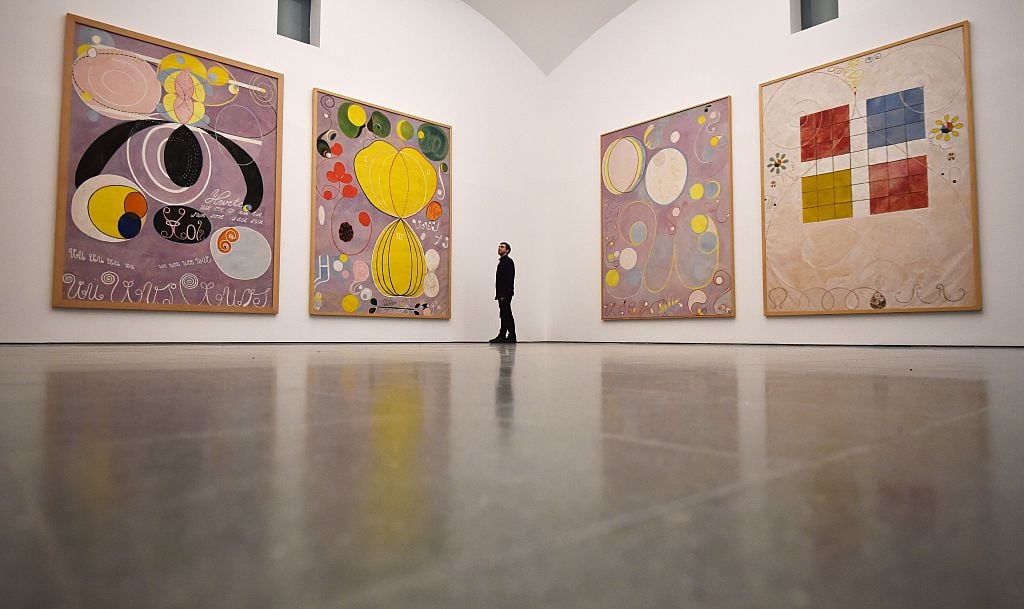
An employee poses with a series art entitled The Ten Largest(1907). Photo Ben Stansall/AFP via Getty Images.
Your book busts a lot of myths, about her life. One of them is that she didn’t want her paintings to be shown, that she kept this pioneering abstract art hidden away. What’s quite poignant from your book is that that’s actually not the case—she was actively trying to get shown, and in a way it struck me as, again, an erasure due to the sexism that was going on. It’s too simple to just say that af Klint was happy to send this off to the future.
Absolutely. She put a lot of energy in that. She was trained as an academic painter and she was used to exhibiting her academic paintings. When she, in 1906, embarked on this new work together with her friend Anna Cassel, she found it much more difficult to find an audience.
The first time she exhibited spiritual works was in 1913 in the context of a spiritual society. And then came World War I, so that limited what could be done. She put something together, which I call the “museum in a suitcase.” She made very small reproductions of her large, big scale, wonderful, beautiful paintings that she glued into 10 albums so she could carry them with her. The entire idea is that you have a small museum that you can travel with and show to other people.
And she went with this to Switzerland, to Amsterdam, and she also managed to show works in London in 1928, but it looks like she didn’t get a lot of responses. So after that, she decided she wouldn’t put any more energy in that, but instead sort of dedicate her work to the future. We should not forget, by then, that she was almost 70 years old, so for a long time she was trying to find an audience.
To enjoy the rest of this interview, tune into it on the Art Angle.
“Hilma af Klint: A Biography” by Julia Voss is available now from Chicago University Press.
